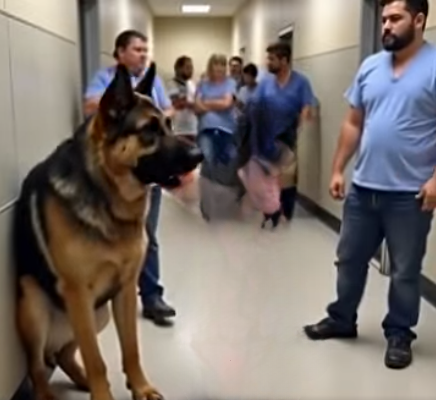The Transformative Journey: How One Woman Turned an Aggressive Shelter Dog into a Loyal Companionon The Transformative Journey: How One Woman Turned an Aggressive Shelter Dog into a Loyal Companion
Animal shelters are often places of hope, but also spaces of quiet sorrow. Behind the rows of kennels lie stories of abandonment, fear, and longing for a home. For every wagging tail ready to leap into the arms of a loving family, there are others burdened with mistrust and pain, overlooked by potential adopters. It was in such a setting that Jessica’s life—and the life of a German Shepherd—would intersect in a way that no one could have anticipated.
A First Visit That Changed Everything
Jessica had always been drawn to animals. From a young age, she felt a connection that went beyond companionship; she could sense their emotions, their fears, and their desires. So when she decided it was time to adopt a dog, she walked into the local animal shelter with a mixture of excitement and nervous anticipation. The air was filled with the chorus of barks, whines, and excited yips, each animal hoping for a second chance.
As she wandered through the aisles, observing dogs of every breed and size, one particular kennel caught her attention. It housed a large German Shepherd with a muscular frame and piercing eyes. However, the moment Jessica approached, a staff member intervened.
“Be careful with him,” warned the shelter worker. “He’s aggressive. We usually recommend avoiding him. He doesn’t trust people easily.”
The word “aggressive” could have discouraged anyone else. But for Jessica, it sparked curiosity rather than fear. She crouched down slightly, letting her gaze meet the dog’s. The Shepherd’s eyes were wary, alert, and intense, yet behind the initial defensiveness, she sensed something more—a deep longing for trust, for love, for a chance.
Listening to a Silent Story
Every animal carries a story, and Jessica believed this Shepherd’s eyes were telling hers. She imagined the experiences that might have shaped his behavior: perhaps he had been abandoned, mistreated, or neglected. His aggression wasn’t cruelty—it was survival, a shield forged from fear.
“Everyone else has given up on him,” she murmured to herself. “I won’t.”
Jessica requested permission from the staff to spend some time with the Shepherd. There was hesitation, of course. Staff members knew the dog could snap if startled or mishandled. Still, they recognized the sincerity in Jessica’s tone and agreed, stipulating that a handler would remain nearby.
And so began the patient work of forming a bond with a dog who had learned to trust no one.
Patience, Presence, and the First Connection
At first, the Shepherd remained distant, growling softly whenever Jessica approached. But she didn’t retreat. Instead, she chose a quiet corner by the kennel and simply sat. Days turned into weeks of this silent routine. She spoke gently, often just narrating her own thoughts aloud, allowing the dog to observe her without pressure.
Jessica discovered that patience was the key. She never forced interactions, never attempted to rush affection. Instead, she let trust build incrementally. She noticed that when she sat with him during feeding time, the dog’s body relaxed slightly, and the intensity in his gaze softened. Small victories—like him taking a treat from her hand—felt monumental.
Shelter staff began to watch in awe. They had seen many potential adopters give up after one or two failed attempts. But Jessica persisted, undeterred by growls, snapping, or retreating behind the kennel wall. She understood that transformation required consistency, empathy, and unwavering faith.
Breaking Down Walls
After several weeks, the Shepherd began allowing Jessica to pet him briefly. Then, slowly, she could scratch behind his ears without eliciting a growl. Her gentle voice and calm demeanor began to unravel the layers of mistrust he had built over years of neglect.
It wasn’t just about taming an aggressive dog; it was about honoring his past while helping him embrace a future. Jessica recognized that his defensive behavior was a language—a message about fear and past pain. She responded with understanding, not punishment.
One day, she knelt down and offered her hand to him, palm up, a gesture of peace. The Shepherd sniffed it cautiously, a subtle tremor running through his frame. Then, almost imperceptibly, he nudged her fingers. That tiny act marked a turning point: the first step toward mutual trust.
The Role of Empathy and Understanding
Jessica’s approach highlights an essential truth in working with difficult animals: aggression is often a mask for vulnerability. Many people misunderstand aggressive dogs, seeing only danger rather than the story of pain beneath. Jessica’s empathy allowed her to see beyond appearances and understand the Shepherd’s true needs: security, consistency, and love.
She worked closely with shelter trainers, learning techniques to reinforce positive behavior while respecting his boundaries. Every small progress—taking a treat, allowing grooming, responding to commands—was celebrated. Each milestone was a testament to patience and careful attention, demonstrating that transformation is possible when fear is met with compassion.
Transforming Fear into Trust
Months passed, and the once aggressive German Shepherd began to blossom under Jessica’s care. His posture changed; he no longer stiffened at sudden movements. His eyes, once sharp with suspicion, glimmered with curiosity and affection. Where growls once echoed, soft whimpers and playful gestures began to emerge.
Jessica often reflected on the journey. “It wasn’t about breaking him,” she explained to friends. “It was about helping him see that the world can be safe, and that love can be consistent. He just needed someone to believe in him when no one else did.”
The shelter staff, initially skeptical, were astounded. They had worked with the Shepherd for years and never imagined he could form such a bond with anyone. Jessica’s persistence and kindness not only transformed the dog but also changed the way the staff approached challenging animals, inspiring a new philosophy centered on patience and understanding rather than avoidance.
The Day He Came Home
Finally, the day came when the Shepherd could leave the shelter. Jessica had named him Max. The bond they had forged in the quiet moments of the shelter would now be tested in a new environment—her home.
Max entered Jessica’s house cautiously, sniffing every corner, alert to every sound. But Jessica remained calm, allowing him to explore at his own pace. Within hours, he curled up near her feet, a silent testament to the trust they had built. Over the next weeks, Max continued to adjust, showing loyalty, affection, and a gentle demeanor that belied his earlier aggression.
Neighbors and friends marveled at the transformation. The once feared dog now greeted visitors with a wagging tail, playful energy, and a calm presence. Jessica’s belief in him had unlocked a side of Max no one thought existed.
Lessons Learned: Beyond One Dog
Jessica’s story is more than a heartwarming tale of adoption—it is a lesson in human compassion, resilience, and the transformative power of patience. She showed that difficult behaviors often conceal deep needs, and that empathy, not avoidance, can change lives.
Animal shelters are filled with overlooked animals—dogs and cats whose fears or past traumas make them seem “unadoptable.” Jessica’s experience encourages a shift in perspective: each animal deserves the opportunity to be seen for who they truly are, beyond first impressions or reputations.
Furthermore, her approach has had ripple effects. Other adopters, inspired by Jessica’s dedication, have begun spending more time with challenging animals, understanding that patience and gentle consistency are far more effective than intimidation or fear.
Max Today: A Testament to Trust
Today, Max thrives in his forever home. He accompanies Jessica on walks, enjoys playful sessions in the backyard, and is adored by everyone who meets him. His transformation stands as a testament to the potential lying dormant in animals that others might label “aggressive” or “untrainable.”
Jessica often reflects on their journey, emphasizing that the key to success was patience, empathy, and an unwavering commitment to seeing the good within Max. “Every dog has a story,” she says. “Sometimes it just takes someone willing to read it with an open heart.”
Conclusion
What began as a hesitant visit to a local animal shelter became a story of courage, compassion, and transformation. Jessica’s willingness to see beyond fear, to invest time and love into an animal labeled “aggressive,” reshaped Max’s life and inspired those around her.
Her story reminds us all that true connection requires understanding, patience, and the courage to act when others hesitate. In a world quick to judge and categorize, Jessica and Max’s journey shines as a beacon of hope, illustrating that even the most wary hearts can learn to trust—and that with care and persistence, remarkable transformations are possible.
The shelter staff who once warned her away now celebrate the bond she formed, using it as a teaching moment for future adopters. Jessica’s story is living proof that empathy can bridge the widest gaps, heal the deepest wounds, and turn a tale of caution into one of inspiration.



